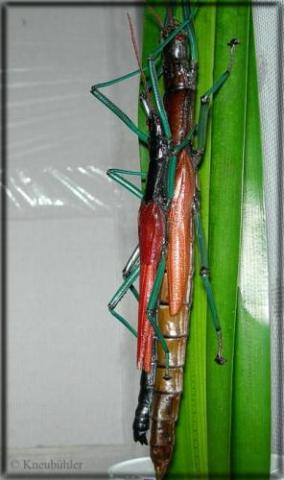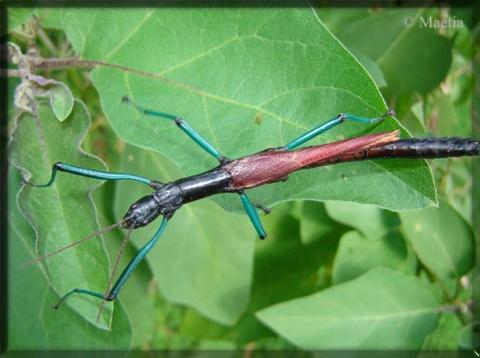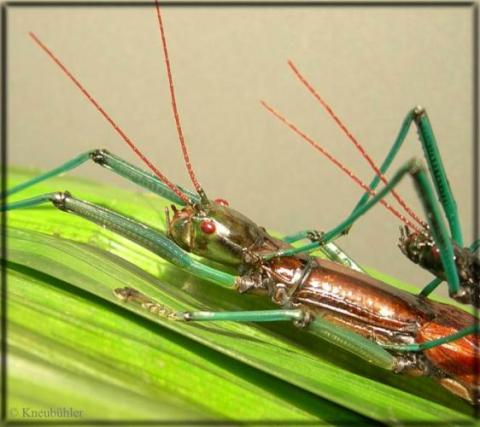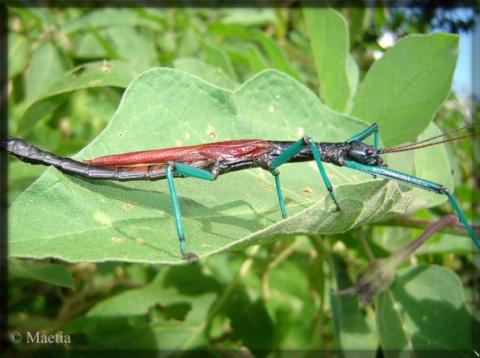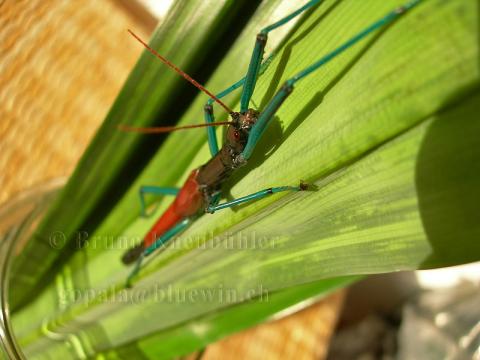
(by Bruno Kneubuehler)
General Notes:
- originally described by Westwood (1859) as Platycrania phelaus
- 2006 - first successful culture of this species by Bruno Kneubühler
- 2007 - distributed as Megacrania phelaus to other breeders
- 2008 - an attempt to breed them exclusively on Mahonia aquifolium was not fully successfull
- 2009 - an attempt to breed this species exclusively on bamboo was also not successfull (only males matured)
- thanks a lot to the following breeders for their additional notes: Mieke Duytschaever
_________________
Origin:
- Central Kwara'ae Province, Malaita (Solomon Islands)
_________________
Females
-
females are about 11 cm long, They do also have well developed wings. So far I have not seen a female fly. And as soon as they start to lay eggs, they might be to heavy to do so - cause then they are quite sturdy
- the colour of the first generation females ranged from a very dark brown to light brown with greenish or greenish-blue legs, orange-brown wings and orange antennae and eyes
- females of subsequent generations tend to be a bit darker in colours
_________________
Males
-
males are about 8 cm long and have well developed wings. They use their wings occasionally for a flight which is more of a clumsy gliding than a real active flying
- males are much more brilliant in colour. They have greenish-blue legs, a shining black body and reddish wings, antennae and eyes
_________________
Eggs
-
large eggs – 10 mm long, 4 mm high, 3 mm wide
- colour is a dark greyish-brown
_________________
Food Plants
- the natural food plant of this species is Pandanus. For the first generation I bought fresh Pandanus leaves in an asian grocery shop. This plant (namelyPandanus amaryllifolius [ = P. odorus]) is being used as a spice in asian (thai) cuisine. In Thailand this plant is called "bay toey". The problem is that Pandanus from such shops can be poisoned with pesticides !
- still I could breed the first generation on such Pandanus – but when the first specimens were adult for some weeks, the Pandanus (from the same shop) was poisoned – and all M. phelaus dopped dead over night. A very frustrating experience, but luckily I had some eggs already
-
for the second generation I got Pandanus from the Zoo in Zurich. You may also get Pandanus from a botanical garden or zoo which might be near your home
- another possibility is that you will buy your own Pandanus plants from a market-garden or a plant shop. But you have to be very careful with plants from such places. Generally one has to assume that ALL plants from such shops are treated with pestizids and / or insectizids. And the poison may remain active (and thus deadly to insects) for a very long time. Leaves from a Pandanus plant I bought prooved to be still poisonous after 1,5 years!
- Further you need to know that Pandanus is quite a slow growing plant. And these insects can eat a lot , especially as adults - what to speak of their way of feeding - which is not that economic to say the least
- a method for an economic way on how to use Pandanus, by Mayk De Haan (BE)
- Golden Cane Palm (Dypsis lutescens, formery known as Chrysalidocarpus lutescens) is well accepted by nymphs and adults. But it is not known whether they will thrive on this food plant in the long run
- Windmill palm (Trachycarpus fortunei) is well accepted by older nymphs and adults (but not accepted by freshly hatched nymphs). But it is not known whether they will thrive on this food plant in the long run
- ornamental grasses (eg Miscanthus) are well accepted by nymphs and adults, but it is not known whether they will thrive on this food plant in the long run
- Mahonia aquafolium as a food plant:
M. aquifolium is a quite frequent garden plant and it is winter green. M. phelaus nymphs will start to feed on this plant readily, despite the hard and leathery leaves. But it seems to be difficult to bring the nymphs up successfully on that plant. Mainly the nymphs will die during moulting (ecdysis), although the humidity might obviously be high. At the moment I know only of one skilled breeder (Mieke Duytschaever) who has been able to get adult M. phelaus specimens by feeding them exclucively on M. aquifolium. Here you find her detailed report on this
These experiences could indicate that M. aquafolium is not a suitable food plant for M. phelaus - Bamboo - this also seems not to be a really suitable food plant for them. I could raise several healthy and big males on bamboo alone. But no female specimen would become adult on bamboo as sole food plant
- common reed (Phragmites) is accepted by nymphs and adults, but small nymphs do not thrive on it
_________________
Breeding Notes
- a very beautiful and actually quite easy to breed species. Just their food plants it not that easy to get - Pandanus
- the eggs were incubated on a damp damp sand. Springtails were used to control fungus (mould)
Incubation temperatures were 18 – 25 °C - nymphs hatch after about 5-6 months
-
important - nymphs may drown in the water container for the food plant ! Therefore cover the container for the food plant, for example with cotton wool
-
but adults are no more in danger to drown, if the container for the food plant is wide enough. They will even stay half submerged in water during the day
-
once you have a steady source for Pandanus to feed them with, they will grow up without further problems
-
I am breeding them in an cage with high humidity, it's floor is covered with constantly wet paper tissue
-
nymphs and adults can be sprayed with (chlorine free) water 2 - 3 times a week, let the water dry up before you spray again
-
nymphs and adults are being kept at room temperatures (18 – 25 °C)
-
males reached adulthood after about 3,5 months , females after about 4,5 months. As usual, males (having one moult less) mature earlier than the females
-
males will stay on the back of a female for a long time. If at all he will leave her again, then only for another "free" females around. He will even stay on her back while eating. Thus he sometimes has to bend his abdomen in a narrow angle.
Bachelor males will try to seize a female which is already occupied by another male. The beset male will strongly defend himself against this attack by excitedly struggling and tapping with his fore legs, his jaws wide open. I have even seen them trying to bite the intruder in the legs and sometimes they do wrestle with each other
Therefore it is advisable not to put more males than females in the same cage. But otherwise they are peaceful creatures - 3 weeks after their final moult, females start to lay eggs - about 8 – 10 a week. They just drop them to the ground
- both nymphs and adults can spray a strong defensive secretion from glands on their prothorax (pronotum). This secretion will burn strongly when it gets into the eyes or on mucosus membrane, but the effect will fade away after some minutes.
Therefore one should handle these insects carefully - it is acutally quite an easy species for breeding - if you have access to enough poison-free Pandanus ...












